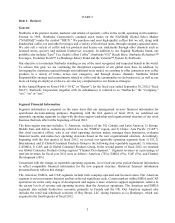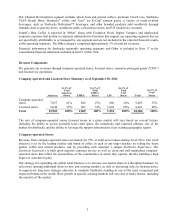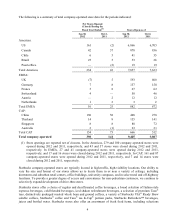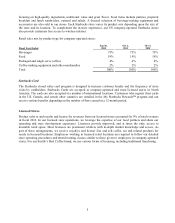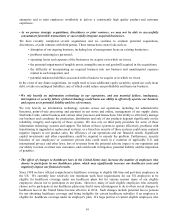Starbucks 2012 Annual Report Download - page 17
Download and view the complete annual report
Please find page 17 of the 2012 Starbucks annual report below. You can navigate through the pages in the report by either clicking on the pages listed below, or by using the keyword search tool below to find specific information within the annual report.11
• labor costs such as increased health care costs, general market wage levels and workers'
compensation insurance costs;
• adverse outcomes of current or future litigation; or
• construction costs associated with new store openings and remodeling of existing stores;
• any material interruption in our supply chain beyond our control, such as material interruption of
roasted coffee supply due to the casualty loss of any of our roasting plants or the failures of third-party
suppliers, or interruptions in service by common carriers that ship goods within our distribution
channels, or trade restrictions, such as increased tariffs or quotas, embargoes or customs restrictions;
• delays in store openings for reasons beyond our control, or a lack of desirable real estate locations
available for lease at reasonable rates, either of which could keep us from meeting annual store
opening targets and, in turn, negatively impact net revenues, operating income and earnings per share;
• the degree to which we enter into, maintain, develop, and are able to negotiate appropriate terms and
conditions, and enforce, commercial and other agreements;
• the impact on our business, especially in our larger or fast growing markets, due to labor discord, war,
terrorism (including incidents targeting us), political instability, boycotts, social unrest, and natural
disasters, including health pandemics that lead to avoidance of public places or restrictions on public
gatherings such as in our stores or cause a material disruption in our supply chain; and
• deterioration in our credit ratings, which could limit the availability of additional financing and
increase the cost of obtaining financing.
•Economic conditions in the US and certain international markets could adversely affect our business and
financial results.
As a retailer that is dependent upon consumer discretionary spending, our results of operations are sensitive to
changes in macro-economic conditions. Our customers may have less money for discretionary purchases as a
result of job losses, foreclosures, bankruptcies, increased fuel and energy costs, higher interest rates, higher
taxes, reduced access to credit and lower home prices. Any resulting decreases in customer traffic and/or
average value per transaction will negatively impact our financial performance as reduced revenues result in
sales de-leveraging which creates downward pressure on margins. There is also a risk that if negative economic
conditions persist for a long period of time or worsen, consumers may make long-lasting changes to their
discretionary purchasing behavior, including less frequent discretionary purchases on a more permanent basis.
•We may not be successful in implementing important strategic initiatives, which may have an adverse
impact on our business and financial results.
There is no assurance that we will be able to implement important strategic initiatives in accordance with our
expectations, which may result in an adverse impact on our business and financial results. These strategic
initiatives are designed to improve our results of operations and drive long-term shareholder value, and include:
• successfully leveraging Starbucks brand portfolio outside the company-operated store base, including
our increased focus on international licensed stores;
• focusing on relevant product innovation and profitable new growth platforms;
• continuing to accelerate the growth of our Channel Development business;
• balancing disciplined global store growth and existing store renovation while meeting target store-level
unit economics in a given market;
• timely completing certain supply chain capacity expansion initiatives, including increased roasting
capacity and construction of a new soluble products plant and a new Evolution FreshTM plant; and
• executing a multi-channel advertising and marketing campaign to effectively communicate our
message directly to Starbucks consumers and employees.



